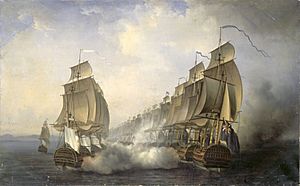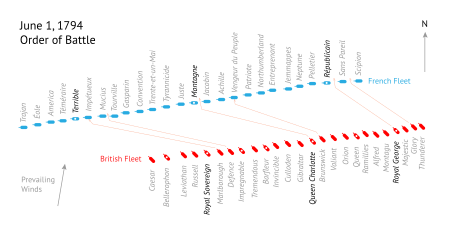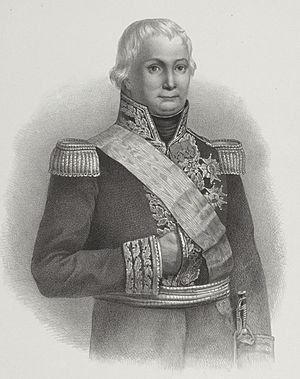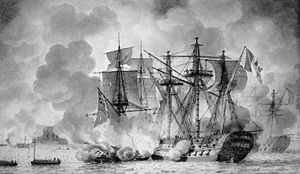Spanish ship Fenix (1749) facts for kids
class="infobox " style="float: right; clear: right; width: 315px; border-spacing: 2px; text-align: left; font-size: 90%;"
| colspan="2" style="text-align: center; font-size: 90%; line-height: 1.5em;" | 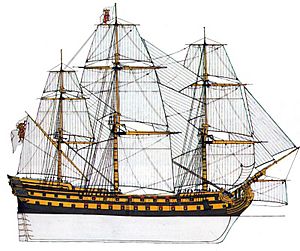
|} The Fénix was a powerful 80-gun ship of the line built for the Spanish Navy. She was made in Havana and launched in 1749. In 1759, she had an important job: bringing the new king, Carlos III, from Naples to Barcelona.
When Spain joined the American Revolutionary War in 1779, Fénix sailed to the English Channel. She was meant to join a huge fleet of over 60 ships from France and Spain. This fleet planned to invade Britain and capture the naval base at Portsmouth.
As the main ship of Admiral Juan de Lángara, Fénix fought in the Battle of Cape St Vincent on January 16, 1780. During this battle, the British Royal Navy captured her. She was then renamed HMS Gibraltar and joined the British fleet.
Gibraltar served in the West Indies, helping to capture Sint Eustatius in 1781. She also took part in the Battle of Fort Royal. Later, her guns were upgraded, and she sailed to the East Indies, fighting in the Battle of Cuddalore in 1783.
During the French Revolutionary War, Gibraltar was part of the Channel Fleet. She fought in the famous Glorious First of June battle in 1794. After some repairs, she served in the Mediterranean and helped in the British campaign in Egypt. Her last major battle was the Battle of the Basque Roads in 1809. In 1813, she was taken out of service and later broken up in 1836.
Contents
| History | |
|---|---|
| Name | Fénix |
| Builder | Havana Dockyard |
| Laid down | 1 July 1747 |
| Launched | 26 February 1749 |
| Commissioned | 1 December 1749 |
| Honours and awards |
|
| Captured | 16 January 1780, by Royal Navy |
| Name | HMS Gibraltar |
| Acquired | 16 January 1780 |
| Honours and awards |
|
| Fate | Broken up, 1836 |
| General characteristics | |
| Class and type | 80-gun third-rate ship of the line |
| Tons burthen | 2,184 25⁄94 (bm) |
| Length |
|
| Beam | 53 ft 3+3⁄4 in (16.2 m) |
| Depth of hold | 22 ft 4 in (6.8 m) |
| Sail plan | Full-rigged ship |
| Complement | 650 |
| Armament |
|
- Fighting at Martinique
- Protecting Tobago
- Battle of Cuddalore
- War with France
- The Glorious First of June
- Mediterranean Service
- Chasing French Ships
- Back to War
- The Basque Roads Attack
Building a Mighty Ship
The Fénix was a large, two-deck ship of the line built in Havana, Spanish territory, using strong mahogany wood. She was launched in 1749.
Her main measurements were:
- Length along the gun deck: 54.5 meters (178 feet, 10.75 inches)
- Length at the keel: 44 meters (144 feet, 6 inches)
- Width (beam): 16.1 meters (52 feet, 11.75 inches)
- Depth in the hold: 6.7 meters (22 feet, 1.75 inches)
She was an 80-gun ship, meaning she carried 80 cannons.
- Lower deck: 30 x 24-pounder guns (cannons firing 24-pound cannonballs)
- Upper deck: 32 x 18-pounder guns
- Quarterdeck: 12 x 9-pounder guns
- Forecastle: 6 x 9-pounder guns
Her sister ship, Rayo, was later made even bigger, becoming a 100-gun, three-deck ship. Sadly, Rayo was wrecked during the Battle of Trafalgar in 1805.
After the British captured Fénix in 1780, they made some changes. They added copper sheathing to her hull, which helped protect the wood from worms and made her faster. This work was done at Plymouth Dockyard and cost a lot of money. The British also changed her guns several times to make her more powerful.
Spanish Adventures
In 1759, Fénix was part of a group of eleven ships. Their mission was to pick up the new king, Carlos III, from Naples. She sailed from Cádiz on August 29 and arrived in Naples on September 28. The King boarded on October 7, and the ships reached Barcelona on October 17.
Fénix spent the next few years sailing in the Mediterranean Sea and the Atlantic Ocean. She had some big repairs between 1764 and 1765. In 1779, when Spain joined the American Revolutionary War, Fénix sailed to the English Channel. She was part of a large fleet planning to invade Britain. However, bad winds delayed the Spanish ships, and the French fleet, which was supposed to meet them, left early.
The Moonlight Battle
By 1780, Fénix was 31 years old. She was not the fastest ship, but she was the largest in Admiral Juan de Lángara's Spanish fleet. On January 16, 1780, a British fleet led by Admiral George Brydges Rodney spotted them.
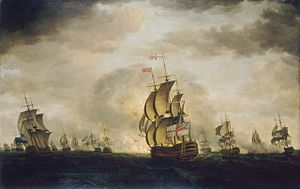
The faster British ships quickly caught up, and the battle started around 4:00 PM. One Spanish ship, Santo Domingo, exploded. Other Spanish ships fought bravely but were eventually captured. Fénix herself fought a long battle against several British ships. She was badly damaged and Admiral Lángara was wounded. Finally, she surrendered to the British ship HMS Bienfaisant.
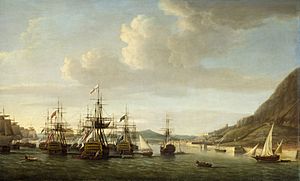
Four Spanish ships were captured and taken into the Royal Navy. Two others were lost after being blown ashore.
Life as a British Ship
After being captured, Fénix was renamed HMS Gibraltar in April 1780. She joined the British fleet in the English Channel. In November, she sailed to the West Indies to join Samuel Hood's squadron.
In 1781, Gibraltar became the main ship for Rear-Admiral Francis Samuel Drake. She was present when the British captured Sint Eustatius from the Dutch in February. The British fleet surrounded the island, and the Dutch governor surrendered without a fight.
Fighting at Martinique
Gibraltar was part of a British squadron blocking four French ships in Fort Royal, Martinique. On April 29, 1781, a large French fleet arrived. The French admiral, François de Grasse, planned to attack.
The two fleets tried to get into the best positions. Gibraltar led the British rear division. The battle lasted about an hour, with ships firing at each other from a distance. Neither side suffered major damage, but the British ship HMS Russell was hit the most. Gibraltar had 6 sailors killed and 16 wounded.
Protecting Tobago
After the battle, the French tried to invade St Lucia and Tobago. The British stopped the attack on St Lucia. But the French sent more troops to Tobago. Admiral Rodney sent Gibraltar and five other ships to help. They found the French fleet too strong and had to retreat. Tobago surrendered to the French two days later.
Gibraltar sailed back to England in August 1781 for repairs. In February 1782, she sailed to the East Indies.
Battle of Cuddalore
In June 1783, Gibraltar was part of a British fleet protecting an army trying to recapture Cuddalore. A French fleet arrived to support the city. The two fleets spent days trying to get the best position. On June 20, they finally fought. The battle lasted about three hours. Both sides took some damage, but no ships were destroyed.
War with France
In 1793, France declared war on Britain. Gibraltar was recommissioned and joined the Channel Fleet. In May 1794, she sailed with the fleet to search for a French convoy carrying grain.
The Glorious First of June
On May 28, 1794, the British fleet found the main French fleet. After some smaller fights and two days of thick fog, the weather cleared on June 1. Both fleets lined up for a major battle. Gibraltar was in the center of the British line.
The British ships were ordered to attack their opposite numbers. Gibraltar helped by stopping a large French ship, the Républicain, from joining the fight against the British flagship. By the end of the battle, six French ships were captured, and one was sunk. The British had fewer casualties. Gibraltar had only two killed and 12 wounded.
Mediterranean Service
Gibraltar was sent to the Mediterranean in May 1795. She fought in a battle off the Hyères Islands in July. Later, in December 1796, she was badly damaged in a storm while anchored off The Rock. Her masts snapped, and she was blown onto a sandbank. She had to return to England for major repairs.
In 1799, Gibraltar was part of a British fleet blocking the port of Cádiz. They were trying to stop the French fleet from leaving. The French fleet, led by Vice-Admiral Étienne Eustache Bruix, managed to escape. They tried to join with the Spanish fleet, but bad winds prevented it. The French fleet eventually returned to port without achieving its goal.
In 1801, Gibraltar helped escort a large British army to Egypt. They arrived in Aboukir Bay in February. The British army landed and fought the Battle of Alexandria, which they won. For her part in this campaign, Gibraltar's crew later received a special medal.
Chasing French Ships
In March 1801, Gibraltar chased a French squadron trying to reinforce French troops in Egypt. The British squadron, led by Rear-admiral Sir John Borlase Warren, pursued the French for days. They spotted the French ships but couldn't catch them, and the French escaped back to port.
Gibraltar also helped relieve the British garrison at Portoferraio in August 1801. She provided sailors and marines for an attack on French batteries.
Back to War
After a short period of peace, war started again in 1803. Gibraltar was one of only ten British ships in the Mediterranean. She later returned to England for more refits and was re-classed as a second-rate ship.
In 1806, Gibraltar and two frigates spotted a French ship called Vétéran, commanded by Jérôme Bonaparte, Napoleon's youngest brother. The British ships chased her, but Vétéran was too fast and escaped.
The Basque Roads Attack
In April 1809, Gibraltar was part of a British fleet blocking the French fleet in the Basque Roads. The British attacked with fireships and explosive vessels. Gibraltars crew helped man the fireships. The attack caused the French ships to panic and run aground. The British spent the next two weeks trying to capture or destroy the stranded French vessels. This was Gibraltars last major battle.
End of Service
Gibraltar was taken out of service around 1813. She was converted into a powder hulk, which is an old ship used for storage. In 1824, she became a lazarette, a ship used to quarantine people. Finally, in November 1836, she was broken up at Pembroke Dock. Some of her strong South American cedar timbers were even used to build parts of another ship, Invalid Optional Parameter.
See also
 In Spanish: Real Fénix para niños
In Spanish: Real Fénix para niños




